Pearl of East: Your travel guide in Uzbekistan.
|
Main Menu
Tashkent
Samarkand
Bukhara
Khiva
Baysun
Nukus
Margilan
Ferghana
Nurata
Namangan
Kokand
Sarmysh Say
Termez
|
News / НовостиUzbekistan: Ichon Qal'a, the inner city of Khiva walkthrough Ichon Qal'a07/02/2017 14:03 After crossing the endless Kyzylkum Desert, in the north-west part of the Republic of Uzbekistan, you will be able to imagine the importance of this oasis city during the times of caravan trade. Apart from its key role as a trade metropolis, it used to be a religious, cultural and scientific centre. The well-preserved old city, Ichon Qal'a, surrounded by a fortification wall, with its numerous mosques, mausoleums, minarets and its four gates has been listed by UNESCO as a World Heritage Site. Opposite Kuhna Ark, is the Muhammad Rakhim Khan II Madrassa (19th cent. AD), used until 1920. The khan was a famous poet, who wrote under the pen name Feruz. The madrassa contains the Museum of Literature and History of Khorezm. Across the main west-east road is the oldest monument of Khiva the Sayid Allauddin Mausoleum dating back to the Timurid period (14th century). The holy site, beautifully tiled with relief majolica, is visited by many Muslims. Sayid Allauddin, a relative of Prophet Muhammad, preached the Islam in Khorezm. Another well-known Muslim pilgrimage site with stunning blue tiling is the Pahlavon Mahmud Mausoleum (14th century). The Sufi, Pahlavon Mahmud, was a famous wrestler, poet, philosopher and furrier. Adjacent to the mausoleum there are the tombs of several khans and their families. Vis-a-vis you can see Sherg'ozi Khan Madrassa built from 1719 to 1726 by war prisoners from Persia. Students from many Central Asian countries studied here.
The next site is Juma Mosque with 213 beautifully carved wooden columns and a minaret (10th-18th cent. AD).
Next to it, there is Islom Hoja Madrassa and the adjacent minaret (20th century), which is the highest observation point in town (57m). The view from the minaret is worth the effort of climbing the dark, narrow staircase. The madrassa houses the Museum of Applied Arts that exhibits ancient Khorezmian handicrafts. Islom Hoja, the vizier of the khan, was a reformer.
He implemented the introduction of the telegraph as means of communication and built a hospital that is still in use and the first New Method School (1910).
Near the Polvon Darvoza (East Gate), is the small Oq Mosque (White Mosque) built in 1657. The huge fortress-like palace, Tosh Hovli, built by Allakuli Khan (1830-1838) is one of Khiva's highlights. The palace had over 100 rooms, beautifully decorated with blue tiles and painted wooden ceilings. Daily, at 17:00, you can watch the performance "At the Khan's Reception" free of charge in the harem. After admiring the historic monuments of Khiva, you should wander off the beaten track to get an impression of people's everyday life. About 2000 people live inside the inner wall.
Stroll down to the colourful Dehqon bazaar located just at the outskirts of Polvon Darvoza. Try some of the delicious nuts, fresh or dried fruit or the bakery products offered there.
|
Calendar
Weather
Useful Links
Searching for Airways and Hotels
|

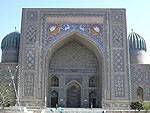
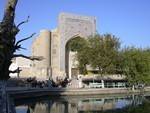
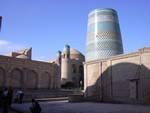
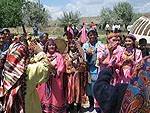
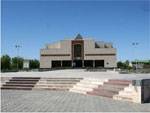
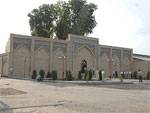
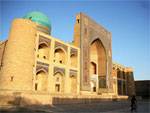
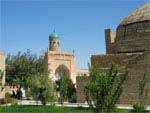
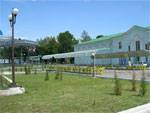


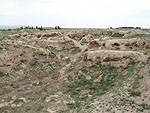





 Some of the columns date back to the 10th century. When the Iranians conquered Khiva in 1740, the mosque was burned. Many columns were replaced by donations from private people.
Some of the columns date back to the 10th century. When the Iranians conquered Khiva in 1740, the mosque was burned. Many columns were replaced by donations from private people.
 In this school Russian, German, and French were taught. The photos and the equipment of the first photographer and film director in Central Asia, X.Devanov, are exhibited here.
In this school Russian, German, and French were taught. The photos and the equipment of the first photographer and film director in Central Asia, X.Devanov, are exhibited here.
 Walk through its streets, enjoy the smell of the fresh bread baked in the tandir ovens, and peep into people's courtyards.
Walk through its streets, enjoy the smell of the fresh bread baked in the tandir ovens, and peep into people's courtyards.